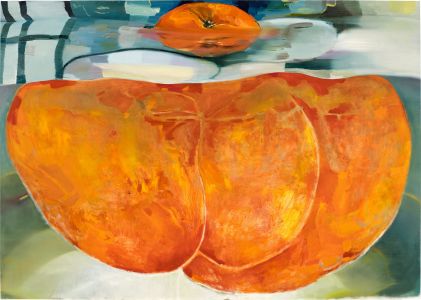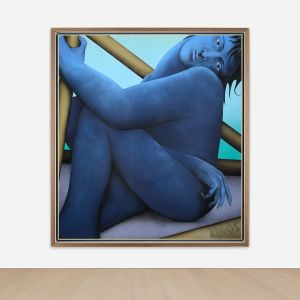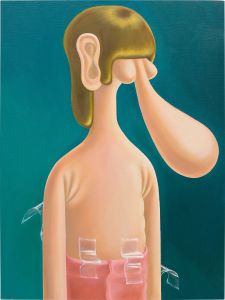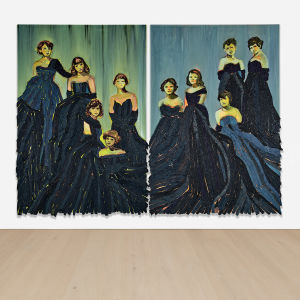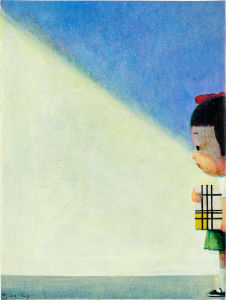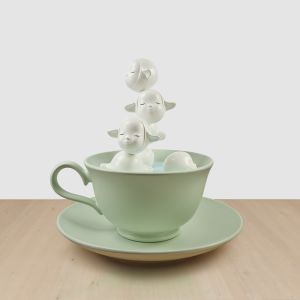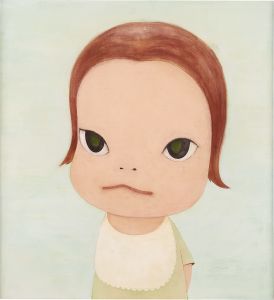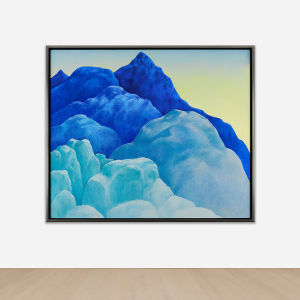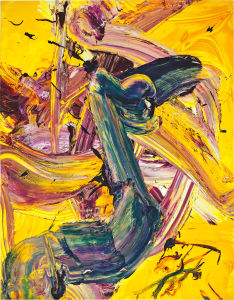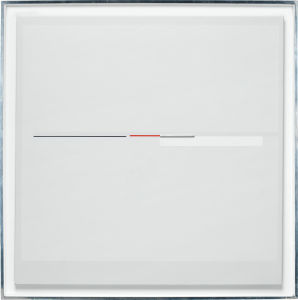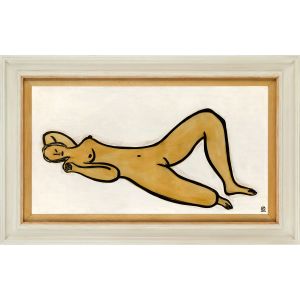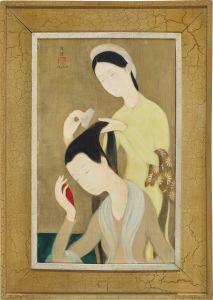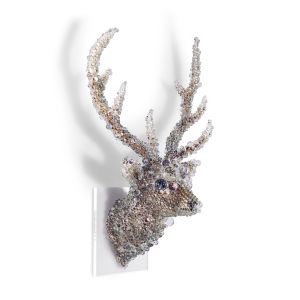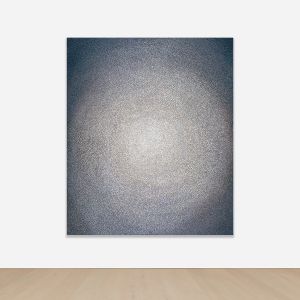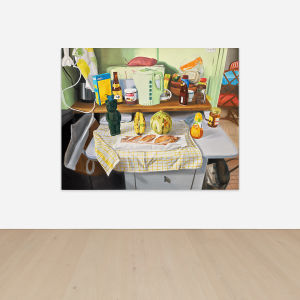
“Sanyu's flowers, his animals, and especially his female nudes exhibit an almost unmatched beauty, full of harmony, inspiring our admiration.”
—— Jean-Claude RiedelSanyu: Ink, Flesh, and the Parisian Chinese Avant-Garde
In 1921, the promising young Chinese artist Sanyu arrived in Paris, joining the last wave of Chinese students under the government-sponsored work-study programme initiated by Cai Yuanpei, the chancellor of Peking University then. Settling in the vibrant Montparnasse district, Sanyu begun pursuing his passion for art at the Grande Chaumière, an art institution renowned for its liberal approach to art education. Soon Sanyu became a member of the Heavenly Dog Society, a bohemian club of expatriate artists and writers studying in Europe, whose members were the vanguard of modernist artistic and literary innovation. i
Members of the Heavenly Dog Society, Paris, 1925.
Left to right: Chang Tao-fan, Sinmay Zau, Liu Jiwen, Sanyu, and Sié Chéou-Kang.
Image: © 2011-2024 The Li Ching Cultural and Educational Foundation, Online Archives of Modern Chinese ArtIn the centre of the Parisian art scene Montparnasse, Sanyu would spend days in the café La Coupole, immersed in his sketches and drawings on the café’s placemats. First opened in 1927, the café was a hub for artists, writers, musicians, who would all gather and engage in creative endeavours.
“I remember Sanyu sitting alone at the back of La Coupole with an empty cup of coffee in front of him. Very often we went to say hello, and he greeted us with such a nice smile: How are you today?”
——Natacha Levy
Photograph of La Coupole
Image: © Arkivi/Picture Alliance / Bridgeman ImagesAt the Grande Chaumière, he wholeheartedly threw himself into figure drawing, focusing intensively on the human form, particularly the nude, which was a subject he had never explored previously. This was a significant departure from the conventions of his native education in China, in which the subject of the nude was considered taboo. He engaged in live drawing sessions with nude models and saw it as an entirely new experience, which subsequently proved to be incredibly fruitful, serving as inspiration for his later paintings of the nude.

Sanyu, Académie de la Grande Chaumière, ca. 1929
Image: © 2011-2024 The Li Ching Cultural and Educational Foundation, Online Archives of Modern Chinese Art
La Grande Chaumière,
Wyndham Editions, Paris, ca. 1930
Image: © 2011-202The Grande Chaumière provided a nurturing environment for Sanyu, which in turn cultivated his artistic experimentation and growth. Working with live models such as the famous muse who was a fixture of the Montparnasse arts scene, Kiki de Montparnasse, he began refining his technical skills and further deepened his understanding of the anatomy, movement and form. Kiki served as one of Sanyu’s most recurring and influential muses, of whom he had made numerous drawings as well as oil paintings, such as the Femme nue sur un tapis (Nude on Tapestry). Widely known by her nickname ‘Kiki’ and beyond modelling, Alice Ernestine Prin was a cabaret performer, nightclub hostess, and writer in Paris. She was renowned for her magnetic charisma and unconventional behaviour, very much reflective of the vibrant and liberated ethos of the Montparnasse counterculture, cementing her status as a legendary muse of the Roaring Twenties in Paris. Aside from having a particularly close and long-working relationship with Sanyu, she posed as a model for many other prominent artists of the era, including Man Ray, Picasso and Modigliani, all creating iconic works featuring her striking features and bohemian style. Of the most highly regarded pieces apart from Sanyu’s most celebrated nude figure paintings from the 1920s, one of the most iconic would be the surrealist photograph of a woman’s back resembling a violin by Man Ray, featuring Kiki as the subject, making her a symbol of the artistic avant-garde and bohemian spirit of the era.

Man Ray, Le Violon d’Ingres, 1924
Image: Dom Slike / Alamy Stock Photo
Artwork: © Man Ray Trust / Artists Rights Society (ARS) / ADAGP, Paris 2024
Sanyu, Femme nue sur un tapis (Nude on Tapestry), 1929
Image: © 2011-2024 The Li Ching Cultural and Educational Foundation, Online Archives of Modern Chinese ArtSuch immersive and hands-on experiences were crucial in developing Sanyu’s distinctive style, characterised by his fluid strokes and the harmonious balance between form and space. The influence of traditional Chinese art, particularly calligraphy, is evident in his brushwork, which combines precision with a sense of fluidity. Tracing back to Sanyu’s early artistic education with the Qing Dynasty master Zhao Xi, this synthesis of Eastern and Western techniques became a hallmark of Sanyu's work, setting him apart from his contemporaries. His unique strokes with the bold linearity are results of his incorporation of Chinese calligraphy into Western techniques. At the Grande Chaumière, upon his first introduction to the subject of the nude and the idea of sketching nude from life, he boldly painted the Western subject with the brush and ink in calligraphy. His experimental approach impressed his fellow students with ‘swiftness, efficiency, and confidence’ .ii In later practices with watercolour and oil, he would exert this calligraphy-inspired line—in its fluidity and spontaneity—to forge a radical form of female nude subverting the Western aesthetic paradigm.
Lacquered Forms of the 1950s and 1960s
Sanyu's works from the 1950s and 1960s signify a pivotal phase in his career, during which he began lacquering and staining furniture for a Chinese merchant in Paris upon returning from New York in 1950. The minimalist lines of ceramic, furniture, and embroidery greatly inspired new experimental approaches in his nude paintings, particularly evident in his bold, decisive, and fluid contours of the body forms and his lacquer-like texture of surfaces. Notably, Sanyu takes to the application of varnish in the present work, treating it almost as an additional colour and only having it applied as a layer to the female body, creating a smooth and glossy finish. This is reminiscent of classical Chinese painters and calligraphers who employ a variation of techniques, skilfully employing dry stiff brushes to create a textured, spontaneous effect that conveys a sense of movement and energy as well as manipulating the fluidity of ink to create broad, atmospheric washes. Furthermore, it calls to mind traditional Chinese potters who mastered the art of glazing techniques to create beautiful patterns. The use of varnish and lacquer is heavily rooted in Chinese arts and craftsmanship such as lacquerware, painting and calligraphy, architectural ornamentation, and ceremonial objects, not only to create a sheen finish, but also protects the surfaces from wear and damage. Though Sanyu’s engagement with traditional Chinese art forms might not be overtly direct, his paintings certainly exhibited qualities that are associated with Chinese artistic sensibilities, largely due to his intuitive artistic origins and extensive knowledge of classical Chinese art. A natural harmony emerges between Sanyu’s lines and spaces, all the while balancing a subject drawn from Western modern art, with techniques deeply rooted in traditional Chinese art. This period stands as a testament to the heightened confidence and pride of Sanyu, as he remarked a few years before his passing in 1966:
“Finally, after a lifetime of being an artist, I now understand how to paint.” iii
—SanyuReimagining the Nude through Chinese Landscape
A rough female nude figure set against a large blank backdrop of ivory, Reclining Nude, with Raised Knee II impresses the viewer with its stunning simplicity. Addressing one of the most canonical subjects in Western oil painting, it nevertheless neither exhibits the idealised feminine beauty in the Western artistic tradition nor showcases the rich painterly texture that the oil medium could have achieved. Rather, the full body of the nude is reduced to a composition using a restrained number of linear strokes and paint dots in black, only sketching out a rough contour that hardly conjures up an image of a nude. Without further rendering to suggest a sense of volume, the figure is filled merely with a flat yellowish colouring. A planar depiction on a near-monochromatic surface—this oil painting yet presents a visuality with more affinity to Chinese ink painting.
Now widely acclaimed, Sanyu’s nude paintings have not only been prime manifestations of his foray into the foreign territory, but has also the artist’s transcultural playground where he rediscovers the various painterly traditions of Chinese literati. For instance, his unique strokes with bold linearity—a very beloved trait of his art—are the results of his incorporation of Chinese calligraphy into Western techniques, developed from his nude sketches with ink since the days at the Grande Chaumière. In his earlier practices, Sanyu had focused more on exerting the flexibility of calligraphy to explore individualised reinterpretations of the Western subject. The resulting form of nude, characterised by an exaggerated bold depiction of the leg, or the ‘cosmic leg’ as described by his contemporary Xu Zhimo, would become one signature of Sanyu’s art. iv An oil-on-canvas work created more than three decades after his first nude in ink, Reclining Nude, with Raised Knee II demonstrates Sanyu’s deeper engagement with calligraphy not only technically but also historically. Employed powerfully, the undecorated stroke with almost no variations displays an archaic clumsiness and roughness traced back to the more ancient zhuan-style calligraphy.
[Left] Sanyu, early sketch with ink, D0011.
[Right] Detail of the present lot
Image: © 2011-2024 The Li Ching Cultural and Educational Foundation, Online Archives of ModernWhat further demonstrates Sanyu’s mastery of enlivening the Western medium with a Chinese vocabulary is his treatment of the composition. Upon closer inspection, the reclining nude—a classical posture in Western art history—is innovatively reinterpreted here with the structure of shanshui (landscape) in Chinese literati painting. On the right half of the canvas, the raised left knee of the nude appears in bold verticality, again emphasising Sanyu’s signature ‘cosmic leg’. In sharp contrast, the remainder of the body is laid horizontally, expanding throughout the canvas towards its left end. This deformed composition breaks away from a centralised one-point perspective, disregarding the rigid emphasis on proportion and precision taught in Western academism. Instead, it is produced through an interplay of verticality and horizontality that encourages a multifaceted engagement with the nude. This unique approach to spatial construction coincides with that of Song dynasty landscape painting.
Viewing the changing shape of the nude in this work, one can recall the famous statement from the Northern Song master Guo Xi (1020-1090) regarding the way of painting mountains: ‘Mountains have three distances. Appreciating the top from the bottom is high distance, peeking the back from the front to the back is deep distance, and viewing the far from the near is level distance.’ v More notably, Song literati found their aesthetic ideal especially in landscapes of eccentricity—for example, the scenery of Yangshuo, Guilin, which had captivated masters including Mi Fu (1051-1107), Su Shi (1037-1101), and Huang Tingjian (1045-1105). Huang Tingjian once wrote about how strange and striking Guilin’s landscape was that even masters including Guo Xi could hardly capture in their paintings. One can almost overlap the figure of Sanyu’s nude with those of the peaks of Guilin in terms of their shared rugged and rocky quality. Against the horizontal layout of the canvas, the composition creates a contemplative mood, inviting a lateral viewing experience as if appreciating a Chinese handscroll painting.
[Left] The monumental ‘cosmic leg’ in the present lot
[Right] Mi Fu, Auspicious Pines in Spring Mountains, Song Dynasty (960-1279)
Image: © National Palace Museum, Taipei
Detail of the present lot: the elongated body which creates a horizontal span. 
Mi Youren, Cloudy Mountains, before 1200
Image: © The Metropolitan Museum of Art, New York, Ex coll.: C. C. Wang Family, Purchase, Gift of J. Pierpont Morgan, by exchange, 1973, 1973.121.1Evoking Chinese shanshui through the Western nude subject, Sanyu is positioned within one of the central debates in Chinese modern art history throughout the twentieth century. During the time of Sanyu, nude and shanshui were commonly deemed to represent the opposing aesthetic paradigms between the West and the East. The former, the emblem of the ideal beauty in Western philosophy, epitomises a humanistic approach based on principles of perspective and verisimilitude; while the latter, the prime embodiment of Chinese literati’s lofty ideal, has long underscored reflecting ideas, conveying thoughts, and capturing spirits over formal likeliness. Not to mention the various controversies accelerating at this moment in China, revolving around, on the one hand, the (im)morality of nudity in art and, on the other hand, ‘undeveloped’ ‘outdated’ literati tradition against the ‘progressive’ Western modernity. Rather than turning his back on either field, Sanyu reflected, reinterpreted, and deconstructed both conventions, through which to transcend the perceived dichotomy in between.
Philosophical Simplicity in the Nude
Sanyu’s paintings of nude figures originated from his study of Western painting techniques. However, it was his deeper philosophical engagement that ultimately led him to artistic fruition and breakthrough. From his early ink sketches in the 1920s to his later large-scale oil paintings in the 1960s, Sanyu had been exaggerating, altering, and deforming the forms of his nude figures, relentlessly and obsessively. It is arguably palpable that there is a more metaphysical frame of reference in his work, which has led the artist to pursue something beyond the merely formal and representational, beyond the visible and tangible—thus reaching into the realm of the philosophical.
Taoist philosophy provides one of the crucial sources for Sanyu’s painting practice, especially his well-known aesthetics of ‘simplification’. Sanyu once responded to his friend: ‘Let me simplify and further simplify. And then, the painting is completed.’ vi His words are almost a direct translation of the famous saying from Tao Teh Ching in the context of painting that ‘Great music has the faintest notes. The Great Form is without shape’. vii Reclining Nude, with Raised Knee II manifests Sanyu’s unique treatment of the subject informed by this philosophy. In this work, Sanyu applies lines and colours in the most restrained manner with only a rough contour in black and a sheer layer of yellowish paint. Sanyu’s simplified nude not only reflects the modernist concern to challenge the reign of mimesis and representation, but also embodies a metaphysical quest for the ‘faintest notes’ in the Taoist vein—seeking the simplest pictorial components that capture the true essential form of the nude. Building upon this simplifying approach, Sanyu further explores ways to enact the ‘faintest notes’, leading to rich expressions and significances. Viewing Reclining Nude, with Raised Knee II alongside his other nudes from the 1950s and 1960s, one can see how Sanyu has been testing myriads of compositional possibilities by changing, removing, and reducing the various elements that forge the image. As such, simplicity serves as a step for Sanyu moving towards abstraction: the female body becomes merely a pretext to create something else, from which to evoke boundless implications for the viewer. The underpinning philosophy here is precisely the Taoist cosmology that ‘The Tao gave birth to One. One gave birth to Two. Two gave birth to Three. Three gave birth to all the myriad things.’viii
Nude, with Raised Knee, Viewed from the Front II, 1965
Image: © 2011-2024 The Li Ching Cultural and Educational Foundation, Online Archives of Modern Chinese Art
Reclining Nude, With Raised Knee II, 1950s-1960s
Image: © 2011-2024 The Li Ching Cultural and Educational Foundation, Online Archives of Modern Chinese Art
Nude, Lying Face Down, 1950s-1960s
Image: © 2011-2024 The Li Ching Cultural and Educational Foundation, Online Archives of Modern Chinese Art
Nude, with Tucked Legs, 1950s-1960s
Image: © 2011-2024 The Li Ching Cultural and Educational Foundation, Online Archives of Modern Chinese Art
Nude, Hugging Knees, Viewed from the Front II, 1950s-1960s
Image: © 2011-2024 The Li Ching Cultural and Educational Foundation, Online Archives of Modern Chinese Art
Nude, with Foot Resting on Knee, Viewed from the Front, 1960s
Image: © 2011-2024 The Li Ching Cultural and Educational Foundation, Online Archives of Modern Chinese Art
Nude, with Raised Knee, Viewed from the Front II, 1965
Image: © 2011-2024 The Li Ching Cultural and Educational Foundation, Online Archives of Modern Chinese Art
Reclining Nude, With Raised Knee II, 1950s-1960s
Image: © 2011-2024 The Li Ching Cultural and Educational Foundation, Online Archives of Modern Chinese Art
“Now, we know that San-Yu exists. We look at his work — which is the center of his life. San-Yu's paintings speak of love and of being alone living with the far away memory of China. The reality of San-Yu's life: a proud intelligent honest and poor artist. It is his soul he has given the flowers, the women, the fish and the leopards - moving through life in silence and harmony.”
— Robert Frank
Nearly a century since Sanyu’s first sketch of nude, we are still captivated by the tremendous energy that stems from his lifelong engagement with the subject. For Sanyu, nudes were so important that they appeared in almost every watershed moment in his art: from the 1920s when he curiously dabbled into the foreign field of Western painting to the 1930s when he boldly experimented with wider expressions and diverse techniques and to the 1950s and 1960s when he eventually ‘[understood] how to paint’. ix As such, the very subject of the nude has become his life imprint, in which he has embodied his thoughts, emotions, and experiences. It is also with these individual footsteps that Sanyu has strived to reflect and transcend the various historical connotations that have burdened the nude as a subject, either in art or in society, thereby moving towards the freedom of his brush.
Created in a late period of Sanyu’s life, Reclining Nude, with Raised Knee II shines as an epitome of Sanyu’s relentless quest into art, his time, and the world. Encapsulated in Sanyu’s boldly exaggerated composition and simplified but powerful linearity are multiple historical vectors. Here, we encounter Sanyu as a pioneer of modernism, bravely breaking away from the shackles of doctrines and constantly seeking new artistic expressions. We also find him a transcultural wanderer, navigating the boundaries between the East and the West, bringing Chinese shanshui to reinvent the Western nude. Moreover, we meet the thinker Sanyu, searching with every brushstroke for the true meaning of art, inquiring into his own positionality, and probing into the nature of the universe. The nude thus becomes a window, through which we delve deeper and deeper into the different facets of the artist, touching upon the ‘centre’ of his life.Collector’s Digest
One of the earliest Chinese artists to study in Paris, Sanyu was born in 1895 in Sichuan, China into a wealthy family of silk business. He is celebrated as one of the pioneering Chinese artists to venture into the Western art world. He moved to Paris in 1921, where he immersed himself in the bohemian lifestyle and quickly became a fixture in the vibrant Montparnasse art scene. Sanyu’s work, characterised by its minimalist lines and subtle interplay of Eastern and Western aesthetics, often focused on nudes, flowers, and animals, with a particular emphasis on the purity of line, influenced by his early training in Chinese calligraphy. The artist started to gain recognition after his death in 1966 and has since been re-evaluated and celebrated worldwide.
Notably, the Musée Guimet in Paris held a significant retrospective, Sanyu: L'écriture du corps in 2004, bringing overdue recognition to his contributions to modern art. His works have been included in retrospectives across major Asian and European museums, including the 1988 China-Paris exhibition Seven Chinese Painters Who Studied in France, 1918-1960 〈中國-巴黎: 早期旅法畫家回顧展,1918-1960〉 at the Taipei Fine Arts Museum and the Musée Cernuschi’s exhibition, Legacy of 20th-Century Chinese Masters, all of which reaffirm his status as a key figure in 20th-century art. Today, Sanyu is celebrated not only for his artistic achievements but also for his role in bridging Eastern and Western artistic traditions.
i Rita Wong, Sanyu: His Life and Complete Works in Oil, vol. I, Taipei, 2024, p. 31
ii Rita Wong, Sanyu: Catalogue Raisonné, Drawings and Watercolors, Taipei, 2014, p. 19.
iii Jiang Meng (Hsiung Ping Ming’s pen name), ‘Potted Flowers: Talking about Sanyu’s Paintings’ [in Chinese], Lion Art Monthly, no. 91, September 1978, p.11
iv Rita Wong, Sanyu: Catalogue Raisonné, Drawings and Watercolors, Taipei, 2014, p. 41.
v Guo Xi, Lin quan gao zhi [in Chinese], Nanjing, 2015, n.p.
vi Sanyu, quoted in Yi Zhuang, eds., World Famous Artist – Sanyu [in Chinese], Shijiazhuang, 2010, p. 211.
vii B. Boisen, eds., Lao Tzu’s Tao-The-Ching: A Parallel Translation Collection, Boston, 1996, n.p.
viii Ibid.
ix Jiang Meng (Hsiung Ping Ming’s pen name), ‘Potted Flowers: Talking about Sanyu’s Paintings’ [in Chinese], Lion Art Monthly, no. 91, September 1978, p.11.
Provenance
Hôtel Drouot, Paris
Jean-François Bideau, Paris
Jean-Claude Riedel, Paris
Acquired from the above by the present ownerExhibited
Taipei, National Museum of History, The Shining Pair of Jade - The Exhibition of San Yu and Pan Yu Lin, 14 October - 26 November 1995
Paris, Musée national des arts asiatiques Guimet, Sanyu - Language of the Body, 16 June - 13 September 2004Literature
The Shining Pair of Jade - The Exhibition of San Yu and Pan Yu Lin, exh. cat., National Museum of History, Taipei, 1995, p.70
Antoine Chen, Overseas Chinese Fine Art Series - SAN YU, Artist Publishing Company, Taipei, 1995, p. 171
Rita Wong, Sanyu: Catalogue Raisonné, Oil Paintings, Lin & Keng Art Publications and Yageo Foundation, Taipei, 2001, Vol. 1, p. 123 (illustrated), Vol. 2, p. 118 (illustrated)
In Search of a Homeland - The Art of San Yu, exh. cat., National Museum of History, Taipei, 2001, p. 31 (illustrated, p. 58)
Rita Wong, Sanyu: His Life and Complete Works in Oil, The Li Ching Cultural and Educational Foundation, Hatje Cantz, Taipei, 2024, Vol. 2, p. 565 (illustrated, p. 342)
Property from the Collection of Doctor Eric Edwards, Paris
✱13
Reclining Nude, with Raised Knee II
signed 'Yu [in Chinese] SANYU' lower right
oil on masonite
67 x 120 cm. (26 3/8 x 47 1/4 in.)
Executed in 1950/1960s, this work is registered under number LCF296 in the archives of the Li Ching Cultural & Educational Foundation.
Estimate On Request
Sold for HK$42,800,000
Danielle So
Specialist, Head of Evening Sale
+852 2318 2027
danielleso@phillips.com
Modern & Contemporary Art Evening Sale
Hong Kong Auction 25 November 2024
22
This lot is no longer available.
